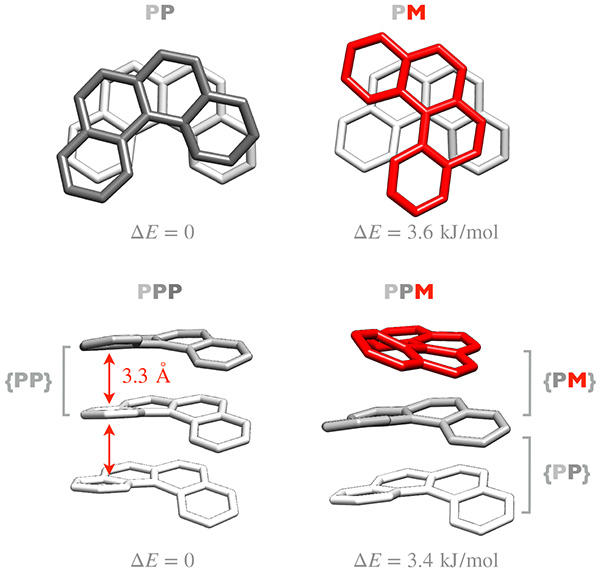A team of scientists from Coimbra, DESY, LISA, Münster, Valladolid, and Angers teamed up with the DESIRS beamline group to study the structural evolution of molecular clusters of [4]helicene, the smallest chiral polycyclic aromatic hydrocarbon (PAH), a chirality due to the helix-like structure of the molecule.
Using photoelectron spectroscopy and high-level theoretical modelling, they discovered that during the growth of [4]helicene aggregates, a homochiral aggregation route is energetically favored over heterochiral arrangements with increasing cluster size up to the heptamer (a cluster consisting of 7 molecules).
On the SAPHIRS endstation of the VUV DESIRS beamline, the international team of scientists performed photoelectron spectroscopy (PES) experiments which revealed evidence for the formation of large clusters of [4]helicene (see Fig. 1), the smallest polycyclic aromatic hydrocarbon that exhibits helical chirality. This type of molecule exists in two forms (P and M enantiomers, whether the helix is right-handed or left-handed) that are mirror images of each other, just like our hands. Understanding the aggregation preferences of interstellar chiral molecules is highly relevant to study chemical processes in the interstellar medium, and PAHs are particularly interesting case studies because of their large abundance in space.

Figure 1: Depiction of the [4]helicene (P and M chiral forms, see structures on the left) cluster distribution from the time-of-flight mass spectrometer obtained at 11 eV photon energy. The lower panel provides a vertical zoom of the above spectrum.
The team studied the formation of aggregates in a molecular beam using the unique capabilities of the i2PEPICO spectrometer of SAPHIRS, which allows photo-ions and photo-electrons generated from VUV excitation events to be recorded in coincidence, enabling the extraction of photoelectron spectra for each cluster size (mass-selected PES) and analyze them independently. From this investigation, a clear trend emerged that showed a decrease in the ionization energy threshold with increasing cluster size. This means that less energy is needed to remove electrons from the larger clusters, compared with the smaller ones, like the dimer and trimer (see Fig.2). Such effect has only been observed once on PAHs, also at DESIRS but in a previous experiment with pyrene C16H10 and coronene C24H12. These, however, were planar PAHs, hinting to some general behavior for PAHs.

Figure 2: Theory vs. experiment: the evolution of the ionization energies with cluster size of [4]helicene clusters (1=monomer -> 7=heptamer). The data extracted from the experiment are compared with (vertical) ionization potentials for the lowest-energy isomers obtained at several levels of theory.
In the current study, the modelling of [4]helicene clusters readily becomes a difficult task because of the many possibilities to combine M and P chiral forms (enantiomers). For example, in the simpler case of the dimer we can have the following possibilities: PP and PM; computing the geometries for larger clusters is computationally costly and there isn’t currently a standardized theoretical method that works for all classes of molecules. The team worked out a series of theoretical approaches using different methods, and they were successful in predicting the ionization energy trend observed in the experiments on SAPHIRS at DESIRS, showcasing the high reliability of the modelling approaches (see Fig. 2).
The corresponding calculated molecular structures suggest that it is energetically more favorable to form clusters using the same chiral forms, i.e., PP, PPP, PPPP and so on, than forming mixed types, such as PM, PMM, PMPM (see Fig. 3). The clusters of the PP, PPP (…) PPPPPPP are designated homochiral, while the mixed types are designated as heterochiral. The team reasoned that such preference for homochiral aggregation routes for chiral PAH may hint at potential symmetry breaking events in space. These results are highly significant for the way we look at cluster formation in the interstellar medium at the scale of small grains.

Figure 3: Calculated molecular structures of the most stable dimer and trimer aggregates of [4]helicene ions for both homochiral (PP and PPP, respectively) and heterochiral (PM and PPM, respectively) forms. P is shown in grey, M is shown in red.
* VUV: vacuum Ultraviolets – part of the UV spectrum absorbed by molecular oxygen in air, below 200 nm (above 6 eV). In practice -on DESIRS beamline- VUV refers to the 6-40 eV range.
